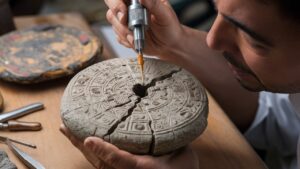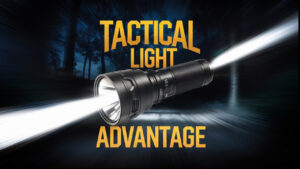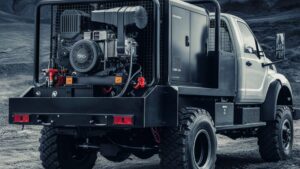Drilling through hardened steel is tough. It requires special drill bits designed for the job.
Understanding the science behind these drill bits helps you choose the right tool. Hardened steel is strong and resistant to wear. Regular drill bits just can’t cut it. Special drill bits are made from hard materials like cobalt or carbide.
Recommended Best Drill Bits for Hardened Steel 2025
| Recommendation | Product |
| Best Overall | MACXCOIP Cobalt Drill Bit Set |
| Popular Choice | BeHappy Drill Bit Set |
| Best Value | YOUGFIN Cobalt Drill Bits |
| Best Budget | COMOWARE Cobalt Drill Bit Set |
| Another Excellent Pick | GMTOOLS 21Pcs Cobalt Drill Bits Set |
They have unique shapes and coatings. These features make them effective at cutting through tough steel. In this blog, we’ll explore the science behind these drill bits. We’ll look at what makes them different and why they work. This knowledge will help you select the best drill bit for your project. Get ready to learn about the amazing world of drill bits for hardened steel.
Introduction To Drill Bits For Hardened Steel
Drilling through hardened steel requires specialized tools. Not all drill bits can handle the toughness of hardened steel. Understanding the science behind drill bits for hardened steel can make your job easier and more efficient.
Importance Of Choosing The Right Bit
The right drill bit makes a huge difference. Using the wrong bit can damage your tool and workpiece. Drill bits for hardened steel are designed to cut through tough materials. They are made from high-speed steel (HSS), cobalt, or carbide. These materials resist heat and wear, making them ideal for tough jobs.
Challenges In Drilling Hardened Steel
Hardened steel is tough. Drilling it presents unique challenges. The material’s hardness can dull regular drill bits quickly. Overheating is another issue. It can damage both the drill bit and the steel. To avoid overheating, use the right drill speed and lubrication. This helps keep the bit cool and extends its lifespan.
Material Composition
Understanding the material composition of drill bits for hardened steel is crucial. Different materials offer unique properties. These properties affect the durability, heat resistance, and cutting efficiency of the drill bits. Let’s explore two common types: High-Speed Steel (HSS) and Cobalt Drill Bits.
High-speed Steel (hss)
High-Speed Steel (HSS) is a popular choice for drill bits. It contains a mix of iron, carbon, and alloying elements like tungsten and chromium. This composition offers several benefits:
- Durability: HSS is tough and can withstand heavy loads.
- Heat resistance: It maintains its strength at high temperatures.
- Cost-effective: HSS bits are affordable and widely available.
HSS is suitable for general-purpose drilling. It can handle hard materials but may struggle with ultra-hardened steel.
Cobalt Drill Bits
Cobalt drill bits are another excellent option. These bits contain a higher percentage of cobalt, typically around 5-8%. This composition offers enhanced properties:
- Superior heat resistance: Cobalt retains hardness at higher temperatures.
- Longer lifespan: These bits are more durable and last longer.
- Better cutting efficiency: Ideal for drilling through hardened steel and stainless steel.
Cobalt bits are more expensive than HSS. But their enhanced performance justifies the cost for tough jobs.
Coating Technologies
Understanding the coating technologies used on drill bits for hardened steel can significantly enhance their performance and lifespan. Different coatings offer unique benefits, improving the efficiency of drilling and reducing wear and tear. This section will delve into two popular coatings: Titanium Nitride and Black Oxide.
Titanium Nitride Coating
Titanium Nitride (TiN) coating is a popular choice for drill bits. This coating provides a hard, gold-colored finish. It significantly improves the bit’s durability and resistance to wear.
Here are some key benefits of Titanium Nitride coating:
- Increased hardness: TiN coating increases the hardness of the drill bit, making it more effective at drilling through hardened steel.
- Reduced friction: The coating reduces friction between the bit and the material, allowing for smoother drilling and less heat buildup.
- Longer lifespan: Drill bits with TiN coating last longer than uncoated bits, providing better value over time.
Black Oxide Coating
Black Oxide coating is another common option. This coating is less hard than TiN but still offers several advantages.
Benefits of Black Oxide coating include:
- Corrosion resistance: Black Oxide provides excellent resistance to corrosion, protecting the drill bit from rust and wear.
- Improved lubricity: The coating enhances the bit’s lubricity, reducing heat and friction during use.
- Cost-effective: Black Oxide coated bits are often more affordable while still providing good performance.
Choosing the right coating for your drill bits can make a significant difference in their performance and longevity. Consider the specific needs of your project and the benefits of each coating type to make an informed decision.
Design Features
Drill bits for hardened steel require specific design features. These features ensure effective drilling and long tool life. Understanding these design elements can help in selecting the right drill bit. Key design features include point angles and flute design.
Point Angles
The point angle of a drill bit is crucial. It affects how the bit cuts through hardened steel. Typical angles range from 118 to 135 degrees. A 135-degree angle is ideal for hardened steel. It offers better control and less wandering. Sharper angles can overheat and wear out quickly.
Flute Design
Flutes are the grooves on the drill bit. They help remove chips from the hole. For hardened steel, a unique flute design is necessary. The flutes should be wide and deep. This allows for efficient chip removal. It also reduces heat buildup during drilling. A proper flute design ensures smooth and effective drilling.
Heat Resistance
Understanding heat resistance is crucial when working with drill bits for hardened steel. The heat generated during drilling can significantly affect the performance and longevity of the drill bit. Let’s delve deeper into the importance of heat treatment and cooling techniques.
Importance Of Heat Treatment
Heat treatment enhances the durability and strength of drill bits. This process involves heating the drill bit material to a specific temperature and then cooling it. This alters the physical and sometimes chemical properties of the material.
There are several types of heat treatments:
- Annealing: Softens the material, making it easier to work with.
- Quenching: Increases hardness by rapid cooling.
- Tempering: Reduces brittleness while maintaining hardness.
Proper heat treatment ensures that the drill bit can withstand the intense heat generated during drilling. This minimizes wear and tear, extending the drill bit’s life.
Cooling Techniques
Effective cooling techniques are essential to maintain the performance of drill bits for hardened steel. Cooling helps to dissipate the heat generated during the drilling process.
Common cooling methods include:
- Coolant Fluids: Specialized liquids that reduce friction and heat.
- Air Cooling: Uses compressed air to blow away heat and debris.
- Mist Cooling: Combines air and liquid for efficient cooling.
Using the right cooling technique prevents overheating, which can damage the drill bit and the workpiece. This ensures precision and efficiency in drilling operations.
In summary, understanding and implementing proper heat resistance measures, including heat treatment and cooling techniques, is vital for optimal performance and longevity of drill bits for hardened steel.
Durability And Longevity
Drill bits for hardened steel must be tough and long-lasting. They face extreme conditions, so durability is key. Longevity depends on the material and design. Proper care ensures they last longer.
Wear Resistance
Wear resistance is vital for drill bits. Hardened steel is tough. Bits must withstand friction and heat. Carbide and cobalt drill bits are excellent choices. They handle wear well.
Maintenance Tips
Proper maintenance extends drill bit life. Use these tips:
- Keep drill bits clean and dry.
- Sharpen bits regularly.
- Store in a cool, dry place.
- Use coolant during drilling.
Follow these tips for best results. Drill bits will perform better and last longer.
Performance Optimization
Drilling into hardened steel requires precision and technique. Performance optimization is key to achieving clean, efficient holes. Understanding the right methods ensures your drill bits last longer and work effectively. Let’s delve into some crucial aspects of performance optimization.
Proper Drilling Speed
Choosing the right drilling speed is essential. Hardened steel demands slower speeds compared to softer metals. High-speed drilling generates excessive heat. This can damage the bit and the material. Slower speeds reduce heat buildup. This prolongs the life of your drill bit.
Start with a low RPM setting. Gradually increase if necessary. Monitor the process closely. If you see smoke or discoloration, reduce the speed. Always prioritize control over speed. This results in cleaner, more precise holes.
Lubrication Use
Lubrication plays a significant role in drilling hardened steel. It minimizes friction and heat. This protects both the bit and the material. Use a suitable cutting fluid or oil. Apply it generously to the drilling area.
Reapply lubrication regularly. This keeps the drilling process smooth. It also helps in removing metal shavings. Proper lubrication ensures a longer lifespan for your drill bit. It also results in better drilling performance.
Always use a lubricant specifically designed for metalwork. This ensures compatibility with your tools and material. Avoid using household oils. They do not provide adequate protection during drilling.

Expert Recommendations
When drilling into hardened steel, expert recommendations can save you time and effort. Knowing which brands and tips professionals trust can make a big difference. Below, we dive into the top brands and tips from professionals for drilling hardened steel effectively.
Top Brands
Choosing the right drill bit brand is crucial for efficient drilling. Here are some top brands experts recommend:
- DEWALT: Known for durability and precision.
- Bosch: Offers high-performance bits for tough materials.
- Irwin Tools: Popular for their cobalt drill bits.
- Makita: Provides reliable and long-lasting drill bits.
Tips From Professionals
Professionals often share valuable tips for drilling hardened steel. Here are some of their top recommendations:
- Use a pilot hole: Start with a smaller bit to make a pilot hole.
- Apply cutting fluid: Keeps the bit cool and reduces wear.
- Drill at low speed: High speed can overheat and damage the bit.
- Use steady pressure: Apply consistent pressure to avoid breaking the bit.
- Sharpen bits regularly: A sharp bit ensures cleaner cuts and longer life.
Following these expert tips and using the right brands can enhance your drilling experience. Efficient drilling requires the right tools and techniques.
Safety Precautions
Working with drill bits for hardened steel requires careful attention to safety. Without proper precautions, injuries can occur. This section covers essential safety measures to follow.
Protective Gear
Always wear protective gear when drilling hardened steel. Safety goggles protect your eyes from flying debris. Ear protection helps guard against loud noise. Gloves shield your hands from sharp edges and heat.
A dust mask prevents inhalation of harmful particles. Steel-toed boots protect your feet from heavy objects. A sturdy apron or jacket can guard your body. Never skip wearing protective gear.
Safe Drilling Practices
Secure the steel piece before drilling. Use clamps to hold it in place. Ensure the drill bit is sharp and undamaged. Start at a slow speed to avoid overheating. Apply steady pressure without forcing the drill.
Lubricate the drill bit to reduce friction. This prevents overheating and extends the bit’s life. Take breaks to let the drill bit cool down. Overheating can weaken the steel and the bit. Keep the work area clean and free of clutter. This prevents accidents and improves efficiency.
Frequently Asked Questions
What Makes Drill Bits Suitable For Hardened Steel?
Drill bits for hardened steel are made from high-speed steel or cobalt. These materials withstand high temperatures and maintain sharpness. They often have a titanium or carbide coating. This enhances durability and cutting efficiency.
How Do You Identify A Drill Bit For Hardened Steel?
Drill bits for hardened steel are typically labeled as HSS or cobalt. They often have a gold or black oxide finish. Their tips are sharp and angled. This design helps in precise and effective drilling.
Are Cobalt Drill Bits Better For Hardened Steel?
Yes, cobalt drill bits are better for hardened steel. They maintain hardness at high temperatures. They last longer and perform better. Their cutting efficiency is superior, making them ideal for tough materials.
Can Regular Drill Bits Be Used On Hardened Steel?
No, regular drill bits should not be used on hardened steel. They lack the necessary hardness and heat resistance. They can wear out quickly or break. Specialized drill bits are recommended for effective and safe drilling.
Conclusion
Understanding the science behind drill bits for hardened steel is crucial. It ensures efficient and safe drilling. Use the right bit for the job. It saves time and reduces wear. Quality drill bits can prevent damage. They also enhance performance.
Knowledge in this area boosts productivity. Proper tools and techniques are key. Always prioritize safety and precision. Happy drilling!








